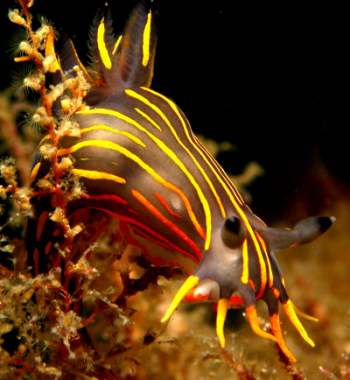

Polycera chilluna
Marcus, 1961
Order: NUDIBRANCHIA
Suborder: DORIDINA
Superfamily: ANADORIDOIDEA
Family: Polyceridae
Subfamily: Polycerinae
PHOTO
off Morehead City, North Carolina, USA]. Depth approx 110 ft. 15 August 2003. Approx 2" in length. Photos: Sandy Smith
Note added 9 Feb 2007: See message #19387 and earlier messages suggesting Polycera chilluna is found in Sth Africa and is a colour form of Polycera capensis.
----------------------------------------
Sandy Smith's photos [copied alongside] of a species of Polycera from North Carolina, on the Atlantic coast of Nth America, suggest that the eastern Atlantic species, Polycera aurantiomarginata García Gómez & Bobo, 1984 is a junior synonym of Polycera chilluna Marcus, 1961, which was described from North Carolina.
Unfortunately, like many of the species described by the Marcuses, the description is based on a single preserved specimen and there is little information on the colour and shape of the living animal. The following useful information on the shape and colour can be extracted from Marcus's description:
"Colors in life fitting typical pattern of Polycera quadrilineata; light brown when preserved with interrupted dark marks. Velar appendages long, pointed, three on left, two on right (one evidently lost}..... the colour agrees with narrow-striped P. quadrilineata...."
In an accompanying drawing of the preserved animal, longitudinally arranged rows of dark elongate spots are illustrated. I assume they represent the yellow-orange colour found in the living animal. Although not mentioned in the text, there are a row of these spots along the edge of the foot, which would suggest that this animal has the orange-yellow border to the foot, so characteristic of P. aurantiomarginata.
Polycera quadrilineata is quite variable in colour, with both white and dark blue colour forms. As shown in earlier photos on the Forum, one lined colour form, with a dark blue background, is very similar in colour to P. aurantiomarginata. Marcus' comment that the colour of his specimen had the 'typical pattern of Polycera quadrilineata' could easily apply as well to P. aurantiomarginata. There are some external differences which separate the two species. One of these, which I have already mentioned, is the orange border to the foot in P. aurantiomarginata, and a second is the presence of 6 velar tentacles in P. aurantiomarginata, and only 4 in P. quadrilineata. In the description of P. chilluna, Marcus describes 5 (and one lost} velar tentacles. Another difference, the yellow tipped rhinophores in P. quadrilineata, and blue rhinophores in P. aurantiomarginata, cannot be determined for P. chilluna from the original description. From published anatomical descriptions of the jaw plates and radula, there is little to distinguish this group of species from one another.
On the available information, it would seem that P. chilluna is an earlier name for P. aurantiomarginata. This would suggest that P. chilluna is a warm water amphi-Atlantic species. It would be interesting to know if its distribution extends into the Caribbean. I would welcome comments on this suggestion.
References:
• Garcia-Gomez, J.C. & Bobo, A (1984) Una nueva especie de Polycera Cuvier (Mollusca: Nudibranchia) del litoral iberico. Cah. Biol. Mar., 25: 361-373.
• Marcus, Er. (1961) Opisthobranchia from North Carolina. Journal Elisha Mitchell Scientific Society, 77(2): 141-151.
• Ortea, J. & Rolan, E. (1989) Descripcion de una nueva especie del genero Polycera Cuvier, 1816 (Mollusca, Nudibranchia) del Archipielago de Cabo Verde. Publicaçoes Ocasionais da Sociedade Portuguesa de Malacologia, 14: 23-28.
• Valles, Y., Valdes, A. & Ortea, J. (2000) On the phanerobranch dorids of Angola (Mollusca, Nudibranchia): a crossroads of temperate and tropical species. Zoosystema, 22(1): 15-31.
Rudman, W.B., 2003 (September 15) Polycera chilluna Marcus, 1961. [In] Sea Slug Forum. Australian Museum, Sydney. Available from http://www.seaslugforum.net/find/polychil
Related messages
Re: Another record of Polycera chilluna from South Carolina
July 13, 2007
From: Tony Fernando
Concerning message #19963:
Hi Dr. Rudman,
As best as I can tell, Mr. Ricker's photograph off South Carolina is a first record for Polycera chilluna in South Carolina. The specimen collected by Dr. Wells and described by Marcus in 1961 is identified as having been collected in Beaufort, North Carolina, and the specimens found by Ms. Smith (messages #10789 and #10981) were on wrecks offshore from Morehead City, NC which is colocated with Beaufort. However, the Beaufort-Morehead City area is south of Cape Hatteras, and it shouldn't be of any particular surprise that a species found there would also be present in South Carolina waters, especially the northern section that includes Myrtle Beach. (There is some dispute on political boundaries, but Hatteras is always a North/South boundary for distributions regardless of which author you use ...) At the same time, Morehead City is North Carolina's second largest deepwater port, while it's certainly possible for all of the P. chilluna records in the Morehead City area to be ballast water transplants from Africa, the presence of specimens over 100 nm southward suggests (to me as an amateur anyways) a population extant in the range from Cape Lookout, NC to Myrtle, SC (at least).
Although a can't argue much with your comment "We know almost nothing about the nudibranchs of South Carolina ..." there are two good references on South Carolina- Eyster's 1980 survey of North Inlet estuary (which I found very readable), and Fox and Ruppert's Shallow Water Marine Benthic Mactoinvertebrates of South Carolina.
Eyster listed the following nudibranchs and scoglossans occuring in South Carolina:
Elysia chlorotica
Ercolania fuscata
Anisodoris prea
Peltodoris greeleyi
Polycera hummi
Polycerella emertoni
Okenia impexa
Ancula evelinae
Doridella obscura (= Corambe obscura )
Dendrodoris warta
Doriopsilla pharpa
Armina tigrina
Tenellia pallida (=T. adspersa, (see Thompson and Brown, 1984))
Learchis poica
Cratena pilata
Dondice occidentalis
Godiva rubrolineata
Spurilla neapolitana
Berghia benteva (possibly Baeolidia? or Anteaeolidiella? )
Berghia verrucicornis (from description probably not A. stephanieae )
Fox and Ruppert add:
Aplysia brasiliana
Berghia coerulescens
Cuthona perca
Doris verruscosa
Fiona pinnata
Miesea evelinae
Okenia sapelona
Placida dendritica
Scyllaea pelagica
Thecacera pennigera
Tritonia bayeri
-
Eyster, L.S. (1980) Distribution and Reproduction of Shell-Less Opisthobranchs from South Carolina. Bulletein of Marine Science, 30(3):580-599.
-
Fox, R. S. and Ruppert E. E. (1985) Shallow-Water Marine Benthic Macroinvertebrates of South Carolina, Species Identification, Community Composition and Symbiotic Associations. Columbia: University of South Carolina Press.
-
Marcus, Er. (1961) Opisthobranchia from North Carolina. Journal of the Elisha Mitchell Scientific Society, 77(2): 141-151
-
Thompson, T.E. and Brown, G.H. (1984) Biology of opisthobranch molluscs Vol. II. London: The Ray Society.
Regards,
Tony Fernando
anthonyfernando@yahoo.com
Fernando, A. V., 2007 (Jul 13) Re: Another record of Polycera chilluna from South Carolina. [Message in] Sea Slug Forum. Australian Museum, Sydney. Available from http://www.seaslugforum.net/find/20063Thanks Tony,
Any further information you can provide on the opisthobranchs of the east coast of Nth America would be very welcome.
Best wishes,
Bill Rudman
Another record of Polycera chilluna from South Carolina
June 1, 2007
From: Brian Ricker
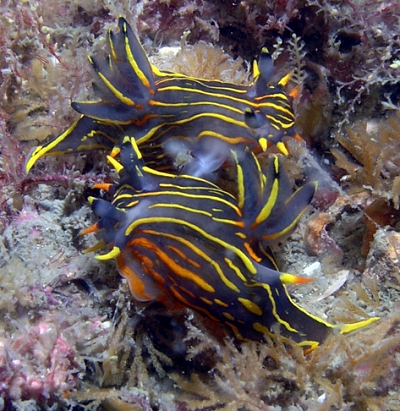
Concerning message #8551:
You said about Hypselodoris picta: "If you find it quite commonly, it would be very interesting to have some photos of it feeding on its food sponge and with its egg ribbons as this is one quick way of comparing it with similarly coloured animals from other parts of the Atlantic."
I took these mating shots over this past weekend. All were taken on the Barracuda Alley artificial reef off of Myrtle Beach, South Carolina
Locality: Barracuda Alley, 50-55 fsw, South Carolina, USA, Atlantic, 27 May 2007. Photographer: Brian Ricker.
Brian Ricker
bricker@nc.rr.com
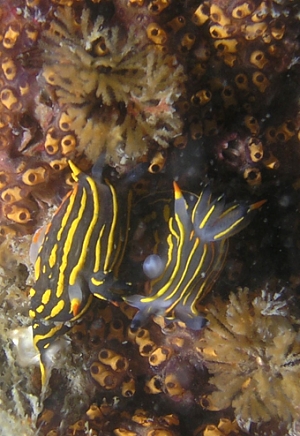
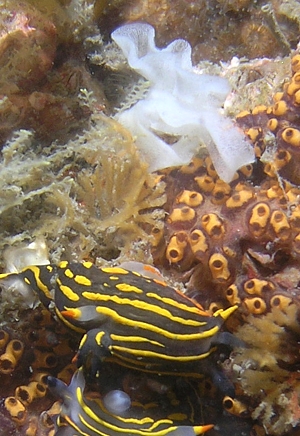
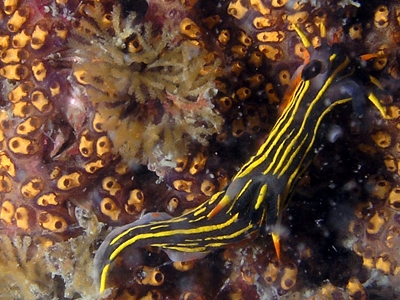
Dear Brian,
We know almost nothing about the nudibranchs of South Carolina so most animals you find there are going to be interesting. Although your animals are blue and have yellow markings, they are not Hypselodoris picta, but they are something which is also very interesting. It is Polycera chilluna which I identified from earlier photos from South Carolina in 2003. Before that it had not been reported since it was named in 1961. Even more interesting is that it is almost certainly the same as Polycera aurantiomarginata, a species which was later named from the other side of the Atlantic.
Your photos certainly confirm its white egg ribbon, similar to quite a number of species of Polycera, and that it feeds on a plant-like bryozoan colony. In your photos, the dominant organism is the small yellow ascidians. I am not sure what purple background is, but I don't think it has anything to do with the ascidians. Whatever they are, species of Polycera do not feed on ascidians but they do feed on plant-like bryozoans like the brown branching colonies in all your photos.
Although I am still waiting for some good photos of the food and eggs of H. picta don't feel bad. It's good to get a some more information on the long-lost P. chilluna.
Best wishes,
Bill Rudman
Another report of Polycera chilluna
September 17, 2003
From: Sandy Smith
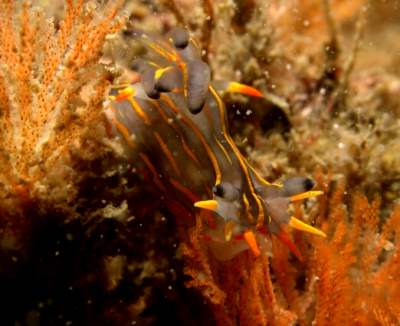
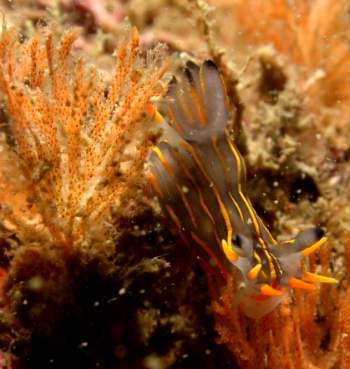
Dear Bill,
I spent this past weekend diving off Morehead City, North Carolina [13-14 September 2003]. I am happy to report that I have found some more specimens of Polycera chilluna (which I now call "Butterfingers nudibranch").
We were diving the German U boat [the U-352] in 110 fsw (located approximately 5 miles from the previous sighting on the Hardy's wreck) on Sept 14 when I spotted a very small specimen 3/4 - 1 inch in length. My husband and I then spotted 6 others in about a 5 foot area. My husband then spotted what we believe to be an egg casing. We did not see any specimens as large as the one seen earlier on Hardy's wreck. Could these be juveniles released from the egg casing? Unfortunately that was our last dive of the trip. Hurricane Isabelle was probably 800 miles away and we had alot of surge on the wreck. I did my best to get a few shots before we had to leave.
I'm not sure if they were feeding or just hanging on. Hope they are still around after the Hurricane.
Sandy Smith
scubanurse69@hotmail.com
Smith, S., 2003 (Sep 17) Another report of Polycera chilluna. [Message in] Sea Slug Forum. Australian Museum, Sydney. Available from http://www.seaslugforum.net/find/10981Dear Sandy,
This is a great addition to your earlier message. I have attached your photos of the egg ribbon, and an animal feeding to a separate message.
The two animals in this message show the colour pattern well, the six tapeting tentacles on the oral veil, and the orange plant-like bryozoan colony on which this animal is clearly feeding. If the satellite photos I have seen on the tv news of your hurricane are anything to go by I suspect these animals will need to produce some form of supaglue from the sole of their foot rather quickly
Best wishes
Bill Rudman
Polycera chilluna - egg mass & feeding
September 17, 2003
From: Sandy Smith
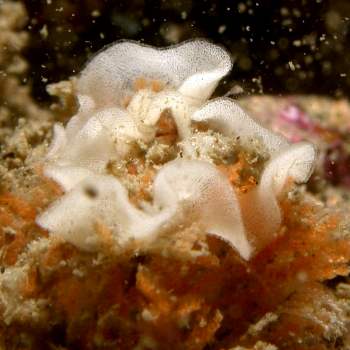
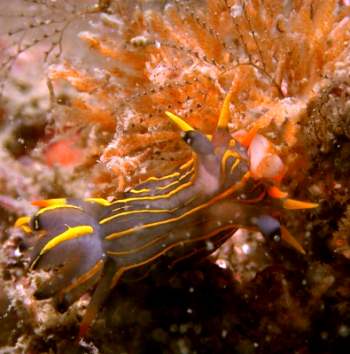
Bill,
Here are the rest of the photos to go with my other message concerning Polycera chilluna.
Morehead City, North Carolina [13-14 September 2003]. We were diving the German U boat [the U-352] in 110 fsw (located approximately 5 miles from the previous sighting on the Hardy's wreck). My husband spotted what we believe to be an egg casing. We did not see any specimens as large as the one seen earlier on Hardy's wreck. Could these be juveniles released from the egg casing? I'm not sure if they were feeding or just hanging on.
Sandy Smith
scubanurse69@hotmail.com
Smith, S., 2003 (Sep 17) Polycera chilluna - egg mass & feeding. [Message in] Sea Slug Forum. Australian Museum, Sydney. Available from http://www.seaslugforum.net/find/10982Thanks Sandy,
Here are the rest of your photos to go with your other message. Although I can't be 100% sure, the size and shape of the egg ribbon, and the fact that it is deposited on the orange bryozoan which they are eating, make me pretty certain that it is their egg ribbon. From the size of the eggs in your photo I am pretty sure this species has free-swimming larvae which spend some time in the plankton so I suspect this egg mass has been produced by one of the animals you saw. From its unbroken appearance, and the tiny white specks [eggs], I don't think the eggs have hatched from this egg ribbon yet.
I am sure your animals are feeding. If you look at the animal in the lower photo you can see a white structure beneath the orange papillae on the front of the head. This white structure is the 'pharynx' or 'buccal bulb' which is everted when the animal in feeding, to bring its teeth and jaws into contact with the food. You can't get much better confirmation that the animal is feeding than this.
Best wishes,
Bill Rudman
Polycera chilluna from North Carolina
August 20, 2003
From: Sandy Smith


Bill,
I found this sea slug on the Artificial wreck of the Hardy's tanker off of Morehead City, [North Carolina, USA]. I have dived the waters off NC probably 100+ times in the past 3 years and have never spotted one like this before. Can you help me identify it. It was in about 110 fsw on a little patch reef located aside the main wreck. You can see in my photo what it was on.
Note added 25 August: "The photo was taken on Aug 15. The animal was, I guess, about 2" in length."
Sandy Smith
Scubanurse69@hotmail.com
Smith, S., 2003 (Aug 20) Polycera chilluna from North Carolina. [Message in] Sea Slug Forum. Australian Museum, Sydney. Available from http://www.seaslugforum.net/find/10789Dear Sandy,
I often say to Forum participants that their message contains 'an interesting find', but these photos beat most of them! I have checked the species described from the east coast of North America, and there is a species of Polycera, Polycera chilluna Marcus, 1961, which was described from North Carolina, and is almost certainly the same species. Of greater interest is that I am sure it is also identical to the species known only from the eastern Atlantic, Polycera aurantiomarginata [Records exist from West Africa - Angola, Senegal - north to Spain and the western end of the Mediterranean. If my identification is correct, then the earliest name for this species, which we now know is found on both sides of the warm water Atlantic, is P. chilluna. I would appreciate a date to add to the locality information you have sent, and some indication of its length.
The plant-like growth it is on is a hydroid colony. These animals are bryozoan feeders so its crawling on a hydroid colony is not biologically significant. It would be good to know more about this species in Nth America, so if you come across further specimens it would be good to see further photos, and possibly egg masses, so we get a fuller idea of colour variation on your side of the Atlantic.
I have discussed the identity of P. chilluna more fully in a separate message.
Rudman, W.B., 2003 (Aug 20). Comment on Polycera chilluna from North Carolina by Sandy Smith. [Message in] Sea Slug Forum. Australian Museum, Sydney. Available from http://www.seaslugforum.net/find/10789Polycera chilluna & P. aurantiomarginata
August 20, 2003
From: Bill Rudman

Sandy Smith's photos [copied alongside] of a species of Polycera from North Carolina, on the Atlantic coast of Nth America, suggest that the eastern Atlantic species, Polycera aurantiomarginata García Gómez & Bobo, 1984 is a junior synonym of Polycera chilluna Marcus, 1961, which was described from North Carolina.
Unfortunately, like many of the species described by the Marcuses, the description is based on a single preserved specimen and there is little information on the colour and shape of the living animal. The following useful information on the shape and colour can be extracted from Marcus's description:
"Colors in life fitting typical pattern of Polycera quadrilineata; light brown when preserved with interrupted dark marks. Velar appendages long, pointed, three on left, two on right (one evidently lost}..... the colour agrees with narrow-striped P. quadrilineata ...."
In an accompanying drawing of the preserved animal, longitudinally arranged rows of dark elongate spots are illustrated. I assume they represent the yellow-orange colour found in the living animal. Although not mentioned in the text, there are a row of these spots along the edge of the foot, which would suggest that this animal has the orange-yellow border to the foot, so characteristic of P. aurantiomarginata.
Polycera quadrilineata is quite variable in colour, with both white and dark blue colour forms. As shown in earlier photos on the Forum, one lined colour form, with a dark blue background, is very similar in colour to P. aurantiomarginata. Marcus' comment that the colour of his specimen had the 'typical pattern of Polycera quadrilineata' could easily apply as well to P. aurantiomarginata. There are some external differences which separate the two species. One of these, which I have already mentioned, is the orange border to the foot in P. aurantiomarginata, and a second is the presence of 6 velar tentacles in P. aurantiomarginata, and only 4 in P. quadrilineata. In the description of P. chilluna, Marcus describes 5 (and one lost} velar tentacles. Another difference, the yellow tipped rhinophores in P. quadrilineata, and blue rhinophores in P. aurantiomarginata, cannot be determined for P. chilluna from the original description. From published anatomical descriptions of the jaw plates and radula, there is little to distinguish this group of species from one another.
On the available information, it would seem that P. chilluna is an earlier name for P. aurantiomarginata. This would suggest that P. chilluna is a warm water amphi-Atlantic species. It would be interesting to know if its distribution extends into the Caribbean. I would welcome comments on this suggestion.
References:
• Garcia-Gomez, J.C. & Bobo, A (1984) Una nueva especie de Polycera Cuvier (Mollusca: Nudibranchia) del litoral iberico. Cah. Biol. Mar., 25: 361-373.
• Marcus, Er. (1961) Opisthobranchia from North Carolina. Journal Elisha Mitchell Scientific Society, 77(2): 141-151.
• Ortea, J. & Rolan, E. (1989) Descripcion de una nueva especie del genero Polycera Cuvier, 1816 (Mollusca, Nudibranchia) del Archipielago de Cabo Verde. Publicaçoes Ocasionais da Sociedade Portuguesa de Malacologia, 14: 23-28.
• Valles, Y., Valdes, A. & Ortea, J. (2000) On the phanerobranch dorids of Angola (Mollusca, Nudibranchia): a crossroads of temperate and tropical species. Zoosystema, 22(1): 15-31.
Best wishes,
Bill Rudman
